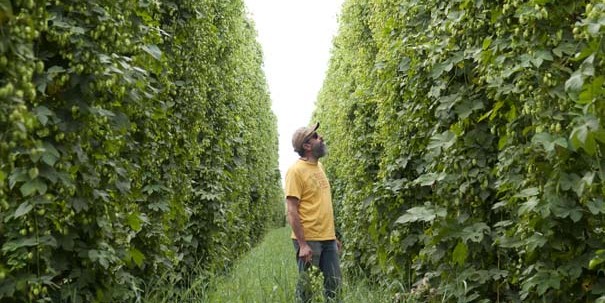
The growing is winding down at Rogue Farms, and the harvest season is just getting started. We’ve done everything we can to grow the finest quality ingredients for our beers, spirits, ciders and sodas. We planted them in the best soil we could find, with the right amount of exposure to the sun. We watered when necessary and put the 7,140,289 Rogue Farms honeybees to work pollinating our Dream Pumpkins, Prickless Marionberries, Jalapeños and Revolution Garden.
Now it’s all up to Mother Nature. Anything could happen in the next couple of months, from hailstorms to picture perfect weather. We’ll accept whatever she gives us and make the most of it. Like most farmers, we’re optimists. The only thing worry ever grows is gray hair. At Rogue Farms, we know what it’s like to dare to grow our own ingredients instead of buying them from someone else, and to accept the risks of being farmers. We do this as we follow our dreams of bountiful harvests and of world-class beer and spirits yet to be mashed, brewed and distilled.
Hive splitting: How we grow bees
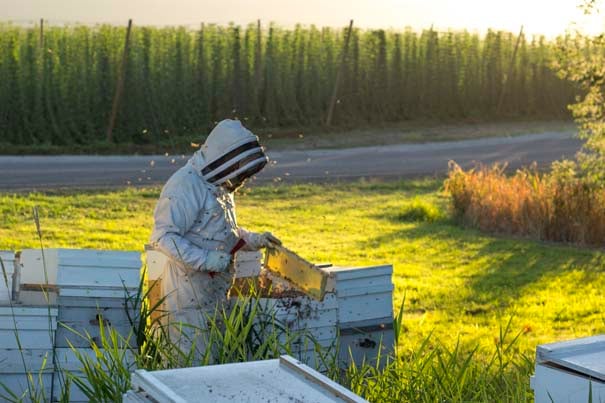
Mid-spring marked the beginning of the busy season in the Rogue Farms apiary. This is the time of year we carefully inspect each colony and take stock of the health of our honeybees. Andrew, Rogue Farms Deputy Undersecretary of Agriculture: Department Bee, surveyed the colonies and came back with the news we were hoping to hear. After spending winter in the almond blossoms of California, and coming home to a strong nectar flow in spring, our 7,140,289 honeybees are as healthy as we’ve ever seen them.
It was time to split the hives and grow more honeybees. Splitting a hive looks simple — at least on paper: Move the queen and about half the worker bees to a new hive somewhere else on the farm. The split hive grows into two new colonies. Our colonies were strong enough to split several of them, increasing the size of our apiary by another 20 to 30 colonies. All that adds up to more honey we can harvest for our meads, kolsch, braggot and soda. But what may look simple requires a lot of careful planning and hard work.
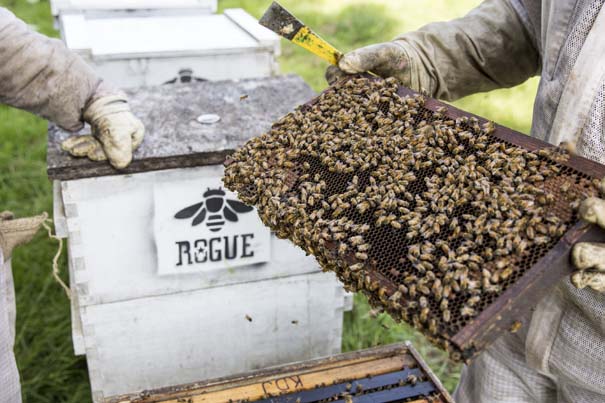
First, we want to know a colony is strong enough to survive a split. We’ll open a hive to see how crowded it looks. The more bees, the better our odds. If a colony is on the verge of overcrowding, then our timing is as good as it gets. Next, we check for a healthy queen and brood. When the queen moves with the workers, she’ll need to be up to the job of laying hundreds of eggs every day for the new colony to grow to full strength.
Some of the brood stays behind. The original colony no longer has a queen, a situation that’s intolerable as far as honeybees are concerned. The remaining workers feed a special substance called Royal Jelly to a select group of eggs, one of which will grow to become the new queen. As long as the workers know a new queen is on the way, they’ll remain calm and carry on.
Finally, we move the split hive to a location that’s far enough away so that the honeybees don’t try to return to the original box. Then we put an empty box on top of the hive so the new colony has room to grow. Hive splitting is our way of helping the honeybees do what comes naturally to them.
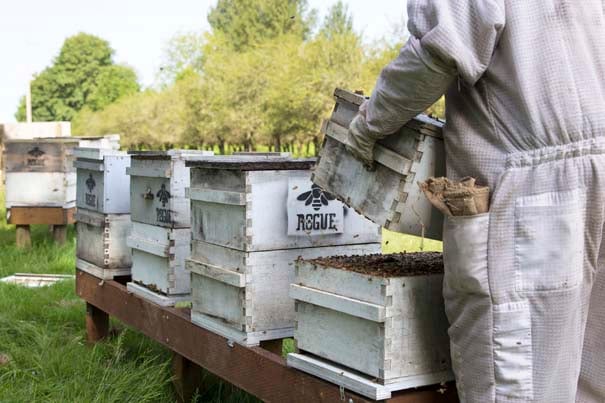
When a hive becomes overcrowded, the queen and half of the workers depart en masse to find a new home. It’s called swarming, and it’s a normal part of a honeybee’s reproductive cycle. Splitting the hive gives us a say on the timing and allows us to keep the new hives here on the farm.
With the start of the summer nectar flow, our honeybees have an abundance of wild berries, wildflowers and crops awaiting them. Taste our Dream Pumpkins, Prickless Marionberries, Jalapeños and all the other flavors of the farm in the next crop of Rogue Farms Wildflower Honey. At Rogue Farms, we do our part by sending our honeybees south during winter, by planting a diverse group of crops for them to forage and pollinate, and by planting wildflowers so they have even more sources of pollen and nectar.
Our honeybees take care of us by producing the honey we use in our beers and sodas. We do our best to take care of them.
Prickless Marionberries
This spring we planted two acres of Rogue Farms Prickless Marionberries. It’s our biggest patch of berries ever. 1602 starters. 1602 holes. All dug, planted and watered by hand. Marionberries are a type of blackberry that originated right across from river from us in Marion County, Oregon. They don’t grow fruit until they’ve experienced a hard frost. Around here, we don’t get that kind of weather until late September, and more likely not until October. So we’ll have nothing to pick from this new planting until next year.
The one thing that drives marionberry farmers crazy are the prickly thorns. They make it harder to harvest and every so often a consumer bites down on one and gets a nasty sting in the mouth. Not exactly good for business. Breeders have been trying to develop thorn-free marionberries for years. They got rid of the thorns, but the berries were small and flavorless.
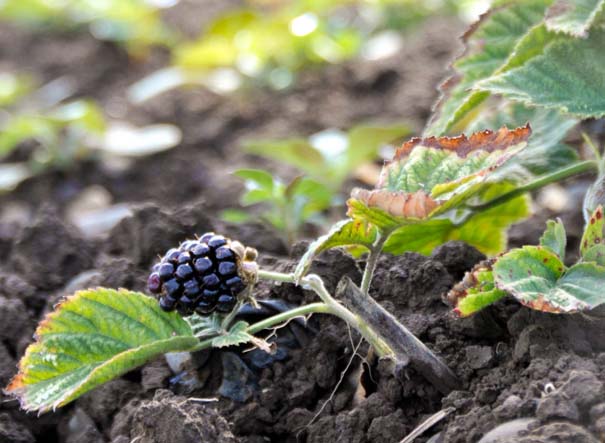
A few years ago, one of our neighbors stumbled across the Holy Grail. Growing in a field he discovered a thornless marionberry that produced excellent fruit. Mother Nature had outsmarted all of the best berry breeders. Rogue Farms is proud to be among a handful of farmers growing his prickless marionberries.
None of this would be possible without the 7,140,289 Rogue Farms honeybees. They’ll pollinate the flowers that grow into marionberries, and bring the nectar back to their hives to produce honey. Only then will Brewmaster John Maier use our marionberries and our honey to craft future batches of Rogue Farms Marionberry Braggot. It’s a long time from planting day to brewing day, but it will be worth it.
In the garden of gin and soda
Come out to Rogue Farms this summer and the other big change you’ll notice is our Revolution Garden. Just a few years ago, this was little more than some planter boxes. Now we’re growing nearly a dozen botanicals and vegetables to distill our Spruce Gin, Pink Spruce Gin and brew our Citrus Cucumber Soda. The list of ingredients growing here includes orris root, angelica, coriander, wormwood, ginger, woodruff, grains of paradise, and juniper.
The biggest expansion of all is in our cucumber patch. We’re adding another 2,024 square feet to the patch, allowing us to increase production by 1,512 pounds of cukes. All of them planted and picked by hand.
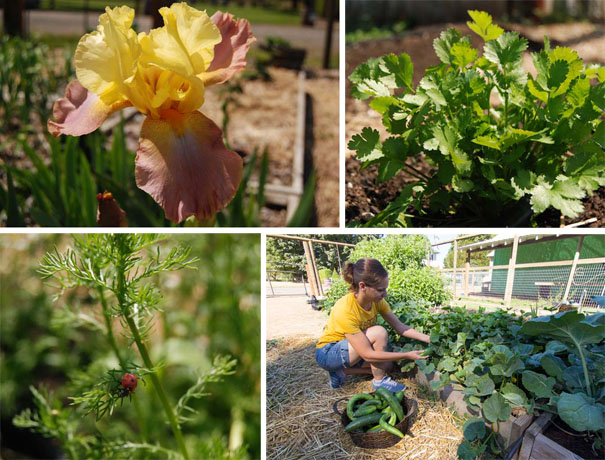
Smoke’em if you grow’em
The last of the ingredients we planted this year was an acre sized patch of Rogue Farms Jalapeños. We started them a while back in the greenhouse. But as they outgrew their tiny pots it was time to move them to where they belong, into the soil next to the Prickless Marionberries, Wigrich Corn and Dream Pumpkins. Look for them along Wigrich Road the next time you head into the farm.
Our secret to growing jalapeños is waiting. Wait until the soil is warm enough and there’s enough sun before planting. Wait even longer for the peppers to fully ripen and turn bright red. Unripe jalapeños are edible and spicy, those are the green ones you see in the grocery store. But we don’t only want spice, we want flavor. So we leave our jalapeños on the plants to mature longer than most growers. The last of the crops we plant is also the last of the crops we pick.
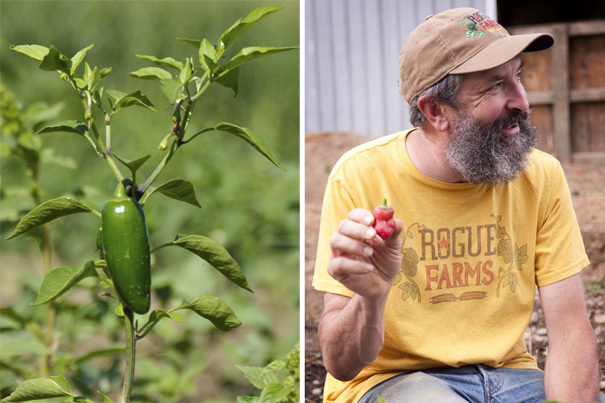
After harvest, we’ll dry the peppers using the kilns here on the farm, the same kilns we used to dry our hops. Then we’ll drive them 77 miles over the Coast Range to the Rogue Distillery in Newport and dry smoke them over fires of cherry and alder. The payoff comes when John uses the peppers we grow, kiln and smoke to brew Chipotle Ale and mash Chipotle Whiskey. It’d be easier and faster to buy someone else’s peppers, or import capsaicin extract from China. But that wouldn’t give us the quality and flavor we want, so we do it ourselves.
Rouge Farms hops and honey report
Hop growers in the Pacific Northwest added another 5,976 acres to their hopyards this year. Total acres strung in 2015 is 43,987, up 16 percent from 38,011 acres in 2014.
|
2014 acreage |
2015 acreage |
% increase |
|
| Oregon |
5,410 |
6,807 |
26% |
| Idaho |
3,743 |
4,975 |
33% |
| Washington |
28,858 |
32,205 |
12% |
| Total |
38,011 |
43,987 |
16% |
There’s plenty of room for more hops, according to the Brewers Association (BA). The BA says that by 2020, hop acreage must grow to 51,000 acres and annual hops production must grow to 90 million pounds to fulfill the future demand for hops by craft brewers. That kind of growth isn’t cheap. The BA estimates that the cost of installing new hopyards, planting more rhizomes, as well as increasing processing and storage capacity will cost the industry $500 to $750 million.
The squeeze on honeybees
The USDA reported this spring that beekeepers lost 42 percent of their colonies from April 2014 to April 2015. This is the second highest rate of loss since USDA began keeping track eight years ago. But what got everyone’s attention was that for the first time, summer losses (27 percent) were bigger than winter losses (23 percent). The conventional wisdom for decades was that winter was the season for losing colonies and summer was the season for rebuilding. How that got turned on its head is not fully understood.
After a steep decline in the early 90s, the number of colonies in the United States has been steady, ranging from 2.4 to 2.8 million per year. But faced with growing losses, beekeepers say those kinds of numbers are not sustainable. The report also confirmed something we’ve suspected for a while. Colony Collapse Disorder went away a few years ago and is no longer a threat to honeybees. Bees face a multitude of problems, from varroa mites, to habitat loss and the still under debate impact of pesticides. But you can scratch CCD from that list.
Hold up. Let’s give these crops a second to grow a little taller. Click “Next” to continue reading/looking at pretty pictures.

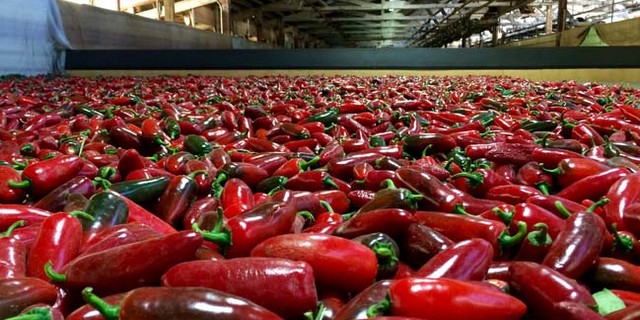

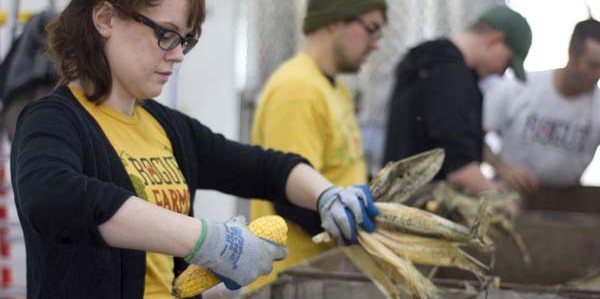


Rogue Farms releases its summer crop report (in a grand photo blog format) http://t.co/TFh3TFB0g1
Rogue Farms releases its summer crop report (in a grand photo blog format) http://t.co/P9OD6GK9iI
RT @CraftBrewingBiz: The Rogue Farms Crop Report (summer 2015). Bees, berries and beyond. @RogueAles @RogueFarms http://t.co/2EaG8sAgh7
RT @CraftBrewingBiz: The Rogue Farms Crop Report (summer 2015). Bees, berries and beyond. @RogueAles @RogueFarms http://t.co/2EaG8sAgh7